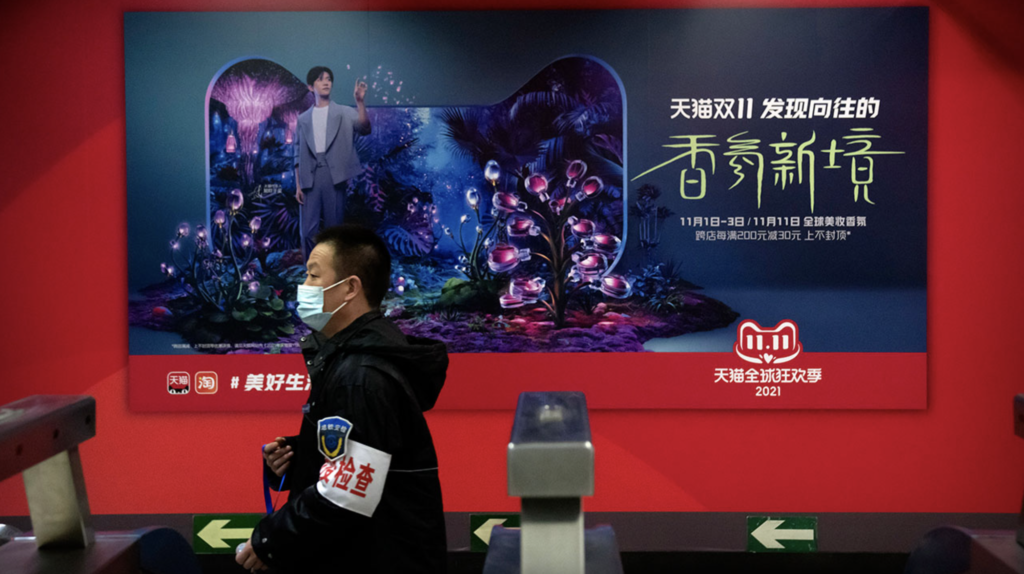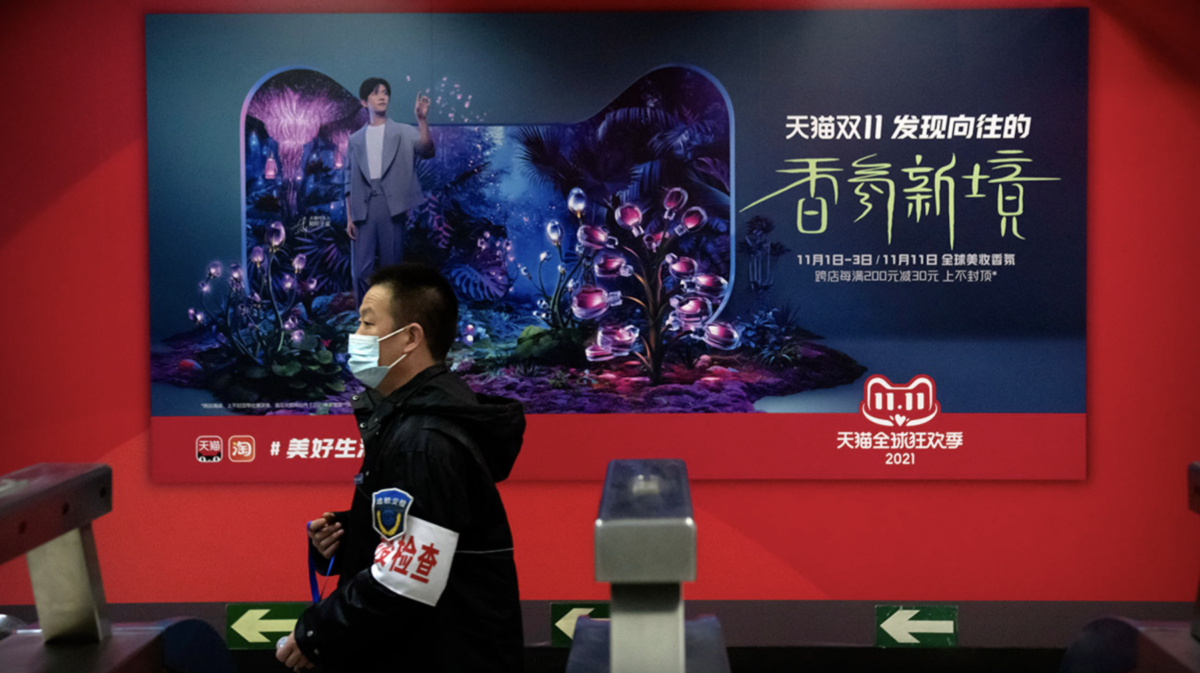The 14th Double 11 (also known as “Single’s Day”) concluded on November 11th at 24:00. It’s the first year eCommerce giants like Tmall and JD didn’t release total GMV (Gross Merchandising Value) data and growth rate. They have gone ambiguous about the figures, as the campaign took place against a weakened economy growth (3.9% YoY GDP growth in Q3), Covid outbreaks, and supply-chain disruption.
In this article, we will go through the highlight of Double 11 this year on Tmall and JD, and explain the new consumption trends in China.

Tmall Double 11 Performance
Tmall announced that the GMV performance was “in line with the previous year despite Covid,” which means around 540.3 billion CNY (~84.5 billion USD at that time) in 2021.
The highlights are:
- 290,000 brands took part in 11.11 over Alibaba’s platforms, the same number as last year.
- 1,009 Tmall Global brands’ GMV more than doubled.
- Some 70,000 brands participated for the first time, including luxury houses Bulgari, Moncler, and Brunello Cucinelli.
- Judging from the number, some brands decided to skip Double 11 this year, or retrieved from the Chinese market facing uncertainty.
- 102 brands achieved 100 million CNY in revenue within one hour, half of which were Chinese brands.
- Mid-tier live streamers’ sales revenue grew by 250%, which is good news for brands looking for cost-effective live-streaming campaigns.
TOP live streamers like Austin Li, Luo Yonghao, and Yu Minhong joined Taobao Livestream, boosting the overall viewership by 600% in the first hour.
Compared to last year, categories like beauty&skincare, underwear&homewear, home electronic appliances, and sports shoes perform better than last year, as consumers adjust their needs and purchases to the “dynamic zero” covid policy, which has no clear end in sight.
JD Double 11 Performance
JD declared that they achieved a higher-than-industry growth rate and set a new record, without further details. They also revealed that high-quality products and big brands have become consumers’ favored choices across product categories.
During the first day of the official sales, we saw some initial results in JD’s efforts penetrating into the premium market: luxury category’s transactions recorded a 113% in the first 10 minutes: LVMH Group’s BVLGARI, CELINE, FENDI, and LOEWE achieved eight times last year’s sales revenue; Apple saw transaction volume jump over RMB 1 billion yuan in the first minute.

Douyin Double 11 Performance
According to Douyin, the number of merchants participating in the Douyin eCommerce Double 11 event increased by 86% year-on-year.
On the first day of the official event, Douyin eCommerce’s one-day GMV (Gross Merchandising Value) increased by 630% compared to the same period last year; ATV (Average Transaction Value) grew 217% in the first hour. The increase in consumer average spending on Douyin eCommerce aligns with our conclusion analyzing Douyin’s TOP 500 best sellers.
According to eCommerce data platform ebrun, In the 38.21 million hours of live broadcast, 7,667 live streaming rooms paid GMV exceeding one million CNY (~140k USD), and the viewership of short videos with shopping cart reached 2,937 billion.
On Douyin eCommerce, 531 products have surpassed one million CNY sales renueve. Here are some categories that did better than Douyin eCommerce’s Double 11 last year:
- makeup: +132% in daily average sales revenue
- fashion apparel, shoes and bags: +21.4% in daily average GMV
- alcohol: +174% in sales revenue
- health & nutrition: +127% in sales revenue
- parenthood & daily necessities: +100% in sales revenue
- consumer electronics & home appliances: +133% in daily average GMV
Although, the industry-level growth could be a higher number of merchants taking part in Douyin eCommerce Double 11. Each brand could tell a different story. However, we can still see the changes in consumer preference from the increase in consumer electronics & home appliances and health & nutrition. We will explain better in the next section what these changes are.

New Consumer Trends in 2023
Value-driven consumption
Chinese consumers have cooled down on impulsive purchases. Instead, they are buying products that can bring physical or emotional value and long-term returns, such as products related to health, sports & outdoors, education, and pet care, as well as services that help save their own time.
JD Health’s SDGP data showed that more than 1,600 nutrition brands doubled their YoY transaction volume, and online consultations with JD Pet Health increased 3.3 times. Over the past five years, service consumption has been expanding from family needs, to sports, health, pet care and more scenarios. Sales of life-related services increased 30 times, that of car maintenance grew 20 times, and bookings for health services were up by 7 times.
source: JD Corporate Blog
Tmall has made a similar announcement:
“Categories such as pets, haircare and outdoor recreational activities are seeing high growth on our platforms,” said Evans, who is responsible for leading and executing Alibaba’s international strategy for globalizing the company and expanding its businesses outside China.
source: Alizila
Responsible consumption
There has been a rising consciousness of responsible consumption and sustainability.
Chinese people are willing to incorporate the concept of sustainability into fashion. For example, whether a fashion item can mix and match multiple items, whether the fabric is natural and reduceable, etc. As more consumers adopt the concept of responsible purchase, minimalistic and reusable fashion items could be the next growing trend.
Douyin eCommerce data shows that 29.9% of users on Douyin pay continuous attention to environmental protection. Among these environmentalists, 83.8% agree with rational consumption, only buying products they really need and good quality; 58.0% prefer items that are more environmentally friendly during the production phase; 43.3% will purchase clothes and bags with a good design using sustainable or reducible fabrics. Therefore, growing public awareness of environmental protection makes sustainable fashion a new trend in apparel consumption.
During this year’s Double 11, Alibaba and JD promised to reduce carbon emissions by 200,000 tons and 60,000 tons, respectively.
JD Logistics estimated that during this SDGP (Single Day Grand Promotion), its green supply chain operations reduced a total of 200,000 tons of carbon, which involves 9 million uses of recyclable packages – avoiding approximately 80,000 tons of one-off packaging waste. One hundred million product packages were delivered with their original packaging boxes from the factories in collaboration with more than 20,000 brand partners.
source: JD Corporate Blog
Cultural confidence: the rise of “proudly made in China”
Proudly made in China, or China-chic (in Chinese: “国潮,” Guochao), has been a booming trend in recent years, especially among Gen-Z. Chinese consumers have stopped the blind belief that western products should be of better quality than “made-in-China.”
According to JD’s data, over the past four years, merchants featuring “China-chic“ increased 240 percent, the amount of products increased 99 percent and new brands under this category grew by 68 percent. On the consumer’s side, shoppers of these products increased 90 percent, and sales were up by 284 percent. SDGP (Single’s Day Grand Promotion) data shows that sales of products with “China-chic” elements increased 124 percent YoY.
source: JD Corporate Blog
The same happens on Douyin: domestic brands have occupied over 90% of the Top 100 best-selling products. Domestic products have clear dominance among categories such as home appliances, makeup, women’s apparel, and food & beverages. In beauty & skincare, international brands like the History of (后), Estee Lauder, and L’Oreal are still at the TOP3. As for the sports shoe category, Nike and Adidas still rank at the TOP2 despite Chinese consumers’ and celebrities’ boycotts due to the brand’s action against Xinjiang cotton.
Conclusion
Chinese consumers are really changing, and international brands need to lean into that change. As a result, people have switched to a more rational, qualitative, and self-fulfilling consumption.
For brands operating in China for a few years, it’s high time we focus more on quality and customer loyalty than pure quantity. As China’s population and economic growth slow down, the demographic dividend is desappearing.
In the new consumption era, brands need to stay solid in their niche positioning while strengthening the emotional connection with their clients or followers. When we talk about the target audience, we need to see the actual person behind the data or number.
Feel free to reach out to us for a tailored consultation for your brand in China.

